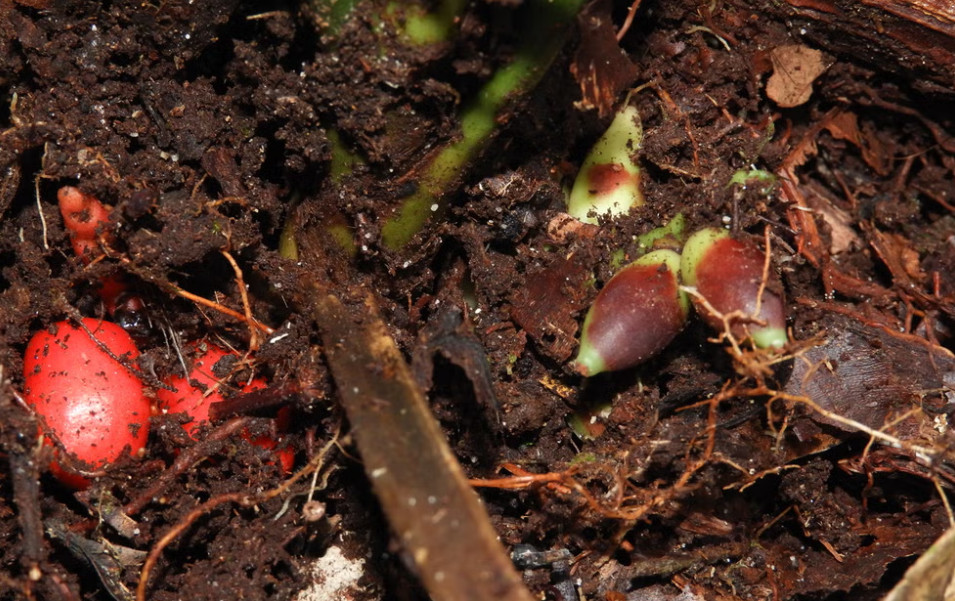Researchers at the Royal Botanic Gardens (RGB), Kew, and their partners discovered a new palm species, which flowers and fruits almost entirely underground. According to the report published in PALMS on Monday, given the new-to-science species’ unique characteristics, it is called Pinanga subterranea, which means ‘underground’ in Latin.
What was the location of the plant?
It is native to Borneo in Southeast Asia, where it is well known to locals. Some of them consume the bright red fruit, which is said to be sweet and juicy.

Scientists have found approximately 300 different palm species on the island, but Pinanga subterranea has been overlooked for years. Locals refer to the plant in three Bornean languages: Pinang Tanah, Pinang Pipit, Muring Pelandok, and Tudong Pelandok.
The researchers found this plant across the primary rainforests of western Borneo and the borders from Malaysia’s Sarawak to Indonesia’s Kalimantan.
Collaboration is necessary
Scientists have overlooked the plant for years because it hid in plain sight.
We would likely have passed this exciting new species by if not for our Malaysian colleague Dr. Paul Chai’s tip, said Dr. Benedikt Kuhnhäuser, a future leader fellow at RGB, Kew, who was also part of the research team.
Instead, we have described the first instance of underground flowering in the palm family, a once-in-a-lifetime discovery.
How does the plant differ from other plants?
Most flowering plants develop their flowers and fruits above ground for pollination and seed dispersal, but a small subset of plants have evolved to do so underground.
Therefore, Pinanga subterranean joins not only the more than 2,500 species of palm (that the scientists know about so far) but also at least 171 species across 89 genera and 33 plant families, which are known to flower and fruit underground through the processes of geology and geocarpy, respectively.
As a result, Pinanga subterranean has both geocarpy and geology, which has baffled researchers since the Pinanga genus is typically pollinated by insects and cannot move around as quickly underground.
According to the international team of scientists, the plant set many seeds and fruit, indicating a successful pollination mechanism.
“I have studied palms for 30 years and am amazed at how they continue to amaze me,” said Dr. William Baker, senior research leader at RBG Kew.
What is pollinating the palm? How does the pollinator find the flowers underground? How did this phenomenon evolve, and what will palms surprise us next?” he asked.
The discovery is not the first.
Agusti Randi, an Indonesian researcher from the National University of Singapore and lead author of the study, encountered a few specimens of the palm in 2017 as well, even though a recent team of international scientists collected specimens and determined that it is a new species to science.
Randi’s study found that at least one of the samples collected appeared to have been dug up or eaten by wild pigs.
“When I first saw the dwarf palm in 2017 in a forest in West Kalimantan, wild boars were digging in the soil around a Pinanga subterranea population, and I found several ripe fruits lying on the ground with a striking, bright red color,” said the lead author.
Furthermore, Randi described how wild boars dug up the stems of the palm to dig up the underground fruit. Their feces were also strewn around in puddles containing seeds.
See Also:
- DBM: New Slaughterhouse in Ormoc City to Strengthen Meat Industry
- Iloilo Island to Get P12.8-M Solar-Powered Water System
- Angat Dam Level Dips Below Minimum
- Hybrid Rice Demo Farm Targets 275 Tons in Davao Del Sur Town
- DA’s Beekeeping Program Set to Go Nationwide
